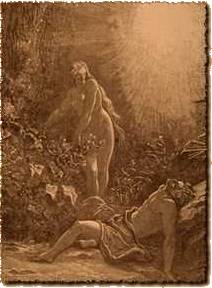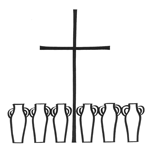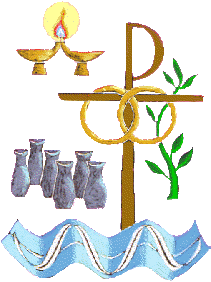
Part Two: Channels of Grace
Marriage

Marriage is not of human origin. It was instituted by God, as described in the opening chapters of the Book of Genesis. But when Christ came into the world He elevated the natural institution to the level of a sacrament. He wished to provide not only individuals with the means they need, as persons, to reach eternal life: He also wanted to give grace to His followers as social beings. Marriage is the foundation of the family, which is the bedrock of human society. In the Church’s own language, the sacrament of Marriage is a contract indeed, but it is also a covenant. The marriage covenant, by which a man and a woman establish between themselves a partnership of their whole life, and which of its own very nature is ordered to the well-being of the spouses and to the procreation and upbringing of children has, between the baptized, been raised by Christ the Lord to the dignity of a sacrament. Consequently, a valid marriage contract cannot exist between baptized persons without its being by that very fact a sacrament (Canon 1055). The only condition, therefore, for a marriage to be a sacrament is that both husband and wife are baptized at the time they marry. This applies to all baptized persons, whether Catholic or not.
Essential PropertiesTwo properties of every marriage are unity and indissolubility. Both qualities acquire a distinctive firmness when the marriage is a sacrament. Unity. By the unity of marriage the Catholic Church understands the monogamy of marriage. This means only one man is married to one woman. It therefore excludes polygamy, which literally means having more than one spouse at the same time (poly = many + gamos = marriage). Historically there have been two forms of polygamy practiced over the centuries. In polygyny a man has more than one wife at the same time (poly = many + gyne = woman). In polyandry a woman has more than one husband at the same time. Popular usage has practically identified polygamy with polygyny, although the two terms do not really mean the same thing. Polyandry is the simultaneous marriage of one woman with two or more men (poly = many + aner = man). Historically less common than polygyny, it was often accompanied by female infanticide as a logical result of a marital system where there was a plurality of potential husbands. Between the two forms of polygamy, polyandry was never permitted or even tolerated throughout the whole period of the Old Testament. Polygyny on the other hand was permitted for a certain time, as appears in the lives of such men as Abraham, Jacob, and David. But with the coming of Christ, polygamy was revoked. The Savior’s language is very clear (Matthew 19:3-9; Mark 10:1-2; Luke 16:18). In the sixteenth century, the Council of Trent condemned anyone who claimed that “Christians are permitted to have several wives simultaneously and that such a practice is not forbidden by any divine law” (November 11, 1563). In the twentieth century, the Church became more explicit. Not only is polygamy forbidden to Christians but, we are told, Christ wished “to condemn any form of polygamy or polyandry.” In other words, since the rise of Christianity, polygamy and polyandry are forbidden to all human beings. The restoration of monogamy, which was originally universal, is itself also universal (Pope Pius XI, Casti Connubii, II). Indissolubility. Practically speaking, what the Catholic Church had especially to defend was not so much simultaneous as successive polygamy. The main challenge to her defense of Christ’s teaching was the claim that married people can divorce and remarry while their first spouse is still living. In order to make her position absolutely clear, the Church distinguishes between what is called internal and what may be called external indissolubility. Internal indissolubility means that a marriage cannot be dissolved from within. What unites a couple in marriage is a deeply interior bond of which God is the Author and which inseparably joins husband and wife before God, until death. It is Catholic doctrine that in a sacramental marriage, this bond is absolutely indissoluble. There have been several uncompromising infallible pronouncements on this crucial area of Christian matrimony.
In practice, the Church understands a marriage to be indissoluble by any human authority, civil or ecclesiastical, when three conditions are fulfilled:
Provided all three of these conditions were fulfilled, there can be no dissolution of the internal bond of such a marriage. External, or outward indissolubility refers to “separation from bed and board or from cohabitation.” Christ Himself provided for this when He told the Pharisees that, “whosoever shall put away his wife, except it be for fornication, and marries another, commits adultery” (Matthew 19:9). There are, therefore, grounds for a temporary or even permanent separation of husband and wife. But the Catholic Church believes that a sacramental and consummated marriage cannot be internally dissolved no matter how grave the reasons which may justify external separation of the spouses. Pauline Privilege. Only a sacramental and consummated marriage is indissoluble by any human authority. What, then, is to be said about marriages that are not sacramental? The Church describes such marriages as held together by a “natural bond.” A natural bond can be dissolved. In general, two forms of non-sacramental marriages exist. Either one or both partners are not baptized when they marry. In both cases, no sacrament of marriage takes place. The classic form of dissolving the natural bond is the Pauline Privilege. It is carefully expressed in the Code of Canon Law. In virtue of the Pauline Privilege, a marriage entered into by two unbaptized persons is dissolved in favor of the faith of the party who received baptism, by the very fact that a new marriage is contracted by that same party, provided the unbaptized party departs…. The unbaptized party is considered to depart if he or she is unwilling to live with the baptized party, or to live peacefully without offence to the Creator, unless the baptized party has, after the reception of Baptism, given the other just cause to depart (Canon 1143). However, even a marriage between a baptized and a non-baptized person can be dissolved “in favor of the faith,” also called “privilege of the faith.” The circumstances would be similar to those of a Pauline Privilege, where one partner wishes to become Catholic but the non-Catholic spouse places grave obstacles to the practice of the Catholic faith. The biblical grounds for the Pauline Privilege and the privilege of faith dissolution of the natural bond are in St. Paul (I Corinthians 7:12-16). Implied in both privileges is that only a valid sacramental and consummated marriage cannot be dissolved under any circumstances.
The SacramentInstituted by Christ to provide a lifetime flow of graces, Christian marriage is a sacrament which the marrying spouses confer on each other. The bishop, priest, or deacon who assists at the marriage is a representative of the Church. He confirms the consent of marriage by the two partners and is an official witness to the marital contract, and the one who presides over the liturgical ceremony.
Since the Second Vatican Council, a dispensation can also be obtained for a Catholic to be married to a non-Catholic without having a bishop, priest, or deacon witness the marriage ceremony. The Catholic Church claims to herself the sole and exclusive right to make laws and administer justice in the matrimonial affairs of baptized persons. Always understood is that the Church’s jurisdiction applies to everything which belongs to the sacrament of Matrimony. Historically this claim of the Church’s rights over the sacrament of Marriage has been one of the main reasons for her periodic conflict with the State. The Church fully recognizes the rights of the State in purely temporal matters, but she insists that, because Christian marriage is a sacrament, Christ entrusted to the Church all final authority over marital morality. The modern popes have repeatedly proclaimed the Church’s authority over Christian marriage. They have seen the legalization of divorce and remarriage, of contraception, sterilization, and abortion. And they continue to insist on the right of married people, and not only Christians, to assistance from the State in making marriage and family life correspond to the will of God.
Graces of the SacramentIn its longest single document, the Second Vatican Council went to great lengths to spell out the marvelous graces that Christ confers on His married followers. Since the sacrament of Matrimony is to be a reflection of the selfless love of Christ for His Church, the principal grace of this sacrament is the gift of selfless love. Christ our Lord has abundantly blessed this love, which is rich in its various features, coming as it does from the spring of divine love and modeled on Christ’s own union with the Church. Just as of old God encountered His people with a covenant of love and fidelity, so our Savior, the Spouse of the Church, now encounters Christian spouses through the sacrament of Marriage. He abides in them in order that by their mutual self-giving, spouses will love each other with enduring fidelity, as He loved the Church and delivered Himself for her…. Marriage and married love are, by nature, ordered to the procreation and education of children . . . true married love and the whole structure of family life which results from it is directed to disposing the spouses to cooperate valiantly with the love of the Creator and Savior, who through them will increase and enrich His family from day to day (The Church in the Modern World, 50). The Church has summarized the graces of the sacrament of Marriage in two terms: “procreative love” and “unitive love.” By the grace of unitive love, married spouses are given supernatural light and strength to remain united and grow in their mutual charity all the days of their lives. But they also receive the grace to share their very being with others, who are not yet conceived or born. Their love is, therefore, also procreative, going outside themselves to the children that God wants to send them. After the children are brought into the world, the sacrament further enables father and mother to provide for the bodily and spiritual needs of their offspring.  Copyright © 2002 Inter Mirifica
Pocket Catholic Catechism |
 When a Catholic enters marriage with a non-Catholic, the
Church must give a dispensation. One of the grounds for the dispensation is a
formal statement made by the Catholic party. There are two parts to the
agreement: “The Catholic party declares that he or she is prepared to remove dangers
of falling away from the faith, and makes a sincere promise to do all in his or
her power in order that all the children be baptized and brought up in the
Catholic Church” (Canon 1125).
When a Catholic enters marriage with a non-Catholic, the
Church must give a dispensation. One of the grounds for the dispensation is a
formal statement made by the Catholic party. There are two parts to the
agreement: “The Catholic party declares that he or she is prepared to remove dangers
of falling away from the faith, and makes a sincere promise to do all in his or
her power in order that all the children be baptized and brought up in the
Catholic Church” (Canon 1125).